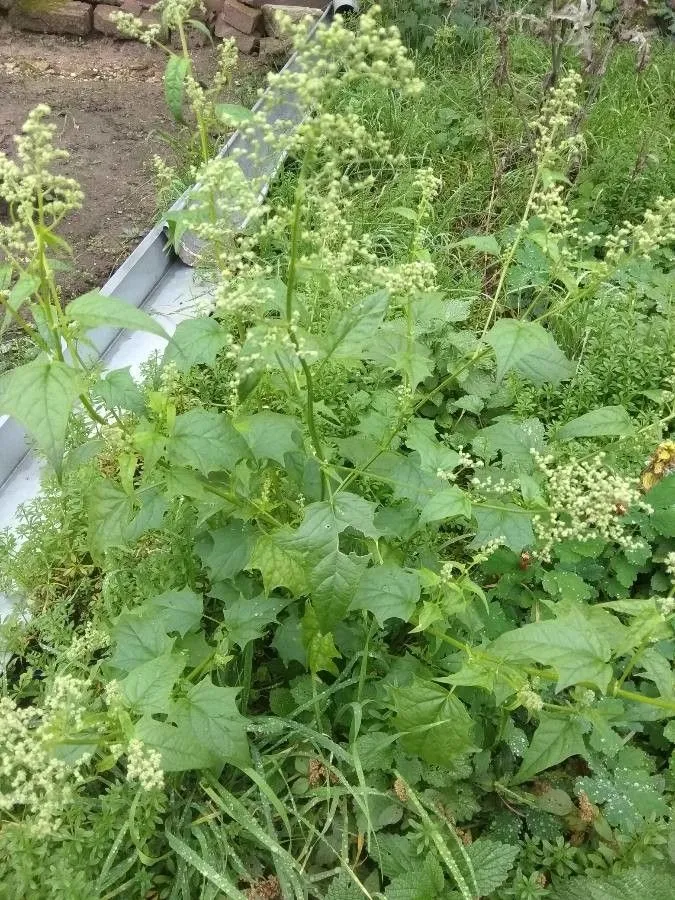
Author: (L.) S.Fuentes, Uotila & Borsch
Bibliography: Willdenowia 42: 14 (2012)
Year: 2012
Status: accepted
Rank: species
Genus: Chenopodiastrum
Vegetable: False
Observations: Europe to N. Japan
The plant known as Maple-leaved goosefoot carries the scientific name Chenopodiastrum hybridum. This intriguing species falls under the Amaranthaceae family, which is renowned for its diverse and ecologically significant members.
Maple-leaved goosefoot is notable for its widespread geographical range, spanning from Europe all the way to Northern Japan. This expansive distribution demonstrates its adaptability to various climates and environments. It thrives in a range of habitats, often found in regions that provide ample sunlight and well-drained soil.
This species is particularly distinguished by its foliage, which bears a striking resemblance to the leaves of the maple tree, providing a distinctive and attractive appearance. The leaves are often broad and lobed, giving them a unique edge among other plants in its genus.
The taxonomic authorship of Chenopodiastrum hybridum is attributed to (L.) S. Fuentes, Uotila & Borsch, as detailed in the botanical literature. The original reference for the scientific classification can be found in Willdenowia, volume 42, page 14, published in 2012. The history of its naming and classification underscores the importance of meticulous botanical research and international collaboration in understanding plant diversity.
Overall, Maple-leaved goosefoot is a captivating example of botanical diversity, reflective of the intricate relationships within the plant kingdom and its adaptation to a wide range of ecological zones.
Deu: bastard-gänsefuß, stechapfelblättriger gänsefuß, unechter gänsefuß
Dan: hjertebladet gåsefod
Eng: mapleleaf goosefoot, sowbane, maple-leaved goosefoot
Swe: lönnmålla
Nld: esdoornganzenvoet
En: Maple-leaved Goosefoot, Sowbane
Az: Hibrid tərə
Be: Лебяда гібрыдная
Ca: Blet angulós
Zh: 杂配藜
Cs: Merlík zvrhlý
Da: Hjertebladet gåsefod
Nl: Esdoornganzenvoet, Bastaardganzevoet, Esdoornganzevoet
Et: Värd-hanemalts
Fi: Vaahterasavikka
Fr: Ansérine hybride, Chénopode hybride, Chénopode à feuilles de Stramoine
De: Bastard-Gänsefuß, Bastardgänsefuss, Breitblättriger Gänsefuß, Stechapfelblättriger Gänsefuß, Stechapfel-Gänsefuß, Unechter Gänsefuß
It: Farinello ibrido
No: Hjartemelde, Hjertemelde
Pl: Komosa wielkolistna
Es: Cenizo híbrido
Cy: Troed yr Ŵydd Fasarnddail, Troed-yr-Ŵydd Dail Masarn
: Maple-leaved goosefoot
Taken Oct 22, 2018 by François Munoz (cc-by-sa)
Taken Oct 25, 2020 by Katalin Szitar (cc-by-sa)
Taken Sep 8, 2019 by Werner Rom (cc-by-sa)
Taken Sep 12, 2021 by Fabrice Rubio (cc-by-sa)
Taken Jul 13, 2019 by Hackbarth Jessica (cc-by-sa)
Taken Oct 25, 2020 by Katalin Szitar (cc-by-sa)
Taken Sep 12, 2021 by Fabrice Rubio (cc-by-sa)
Taken Sep 12, 2021 by Fabrice Rubio (cc-by-sa)
Taken Sep 8, 2019 by Werner Rom (cc-by-sa)
Taken Aug 13, 2019 by Max Deb (cc-by-sa)
Taken Jul 6, 2013 by Tela Botanica − Jacques Maréchal (cc-by-sa)
Taken Oct 25, 2020 by Katalin Szitar (cc-by-sa)
Taken Jul 22, 2017 by Tela Botanica − Marcel ETIENNE (cc-by-sa)
Taken Aug 5, 2011 by Tela Botanica − Bertrand BUI (cc-by-sa)
Taken Aug 5, 2011 by Tela Botanica − Bertrand BUI (cc-by-sa)
Taken Aug 13, 2006 by Tela Botanica − Christophe GIROD (cc-by-sa)
Taken Aug 13, 2006 by Tela Botanica − Christophe GIROD (cc-by-sa)
Ph maximum: 8.0
Ph minimum: 7.5
Light: 7
Atmospheric humidity: 5
Bloom months: [‘jul’, ‘aug’, ‘sep’]
Soil nutriments: 8
Family: Myrtaceae Author: (F.Muell.) K.D.Hill & L.A.S.Johnson Bibliography: Telopea 6: 402 (1995) Year: 1995 Status:…
Family: Rubiaceae Author: Pierre ex A.Froehner Bibliography: Notizbl. Bot. Gart. Berlin-Dahlem 1: 237 (1897) Year:…
Family: Sapindaceae Author: Koidz. Bibliography: J. Coll. Sci. Imp. Univ. Tokyo 32(1): 38 (1911) Year:…
Family: Asteraceae Author: A.Gray Bibliography: Pacif. Railr. Rep.: 107 (1857) Year: 1857 Status: accepted Rank:…
Family: Fabaceae Author: Medik. Bibliography: Vorles. Churpfälz. Phys.-Ökon. Ges. 2: 398 (1787) Year: 1787 Status:…
Family: Aspleniaceae Author: (Cav.) Alston Bibliography: Bull. Misc. Inform. Kew 1932: 309 (1932) Year: 1932…